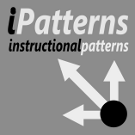iPatterns: Instructional Patterns
The concept of “pattern languages” was developed by philosopher-architect Christopher Alexander. In his explanation of pattern languages he described his use of patterns in a “Child’s history of pattern languages” found on his website www.patternlanguage.com.¹
…a pattern is an old idea. The new idea in the book was to organize implicit knowledge about how people solve recurring problems when they go about building things. For example, if you are building a house you need to go from outside to inside and there are centuries of experiments on how to do this in a “just so” way. Sometimes the transition is marked not by just a door but by a change in elevation (steps, large, small, straight, or curved), or a shaded path, or through a court yard. We wrote up this knowledge in the form of a pattern about entrance transitions. Patterns are easy to remember and set out as if-then propositions. The book gave 253 patterns about solutions that are known to work.
In Alexander’s works, “patterns” are solutions to generic (architectural) problems, arrived at intuitively, confirmed empirically, and recorded encyclopedically for later use by others. These patterns fit into larger patterns, which in, in turn, fit into sequences.
Of course, Alexander’s concept of pattern languages would have remained an obscure architectural method or “style” had it not been that it has been adopted by several fields outside of architecture. He notes,
People liked our book very much. We were surprised though, when we found out computer programmers liked it, because it was about building not programming. But the programmers said, “this is great, it helps think about patterns in programming and how to write reusable code that we can call upon when we need it.”
In fact computer programmers, user interface designers, and experts in several other fields have adopted the idea of pattern languages because it organizes and simplifies otherwise difficult concepts and expressions. The current concept of object-oriented languages grew, in part, from Alexander’s pattern language applied to computer programming languages.
While a few attempts have been made to apply the concept of patterns to instructional², this is the first I know of to use a “wiki” to that end. For additional details, please go to the wiki, www.ipatterns.org. (This text adapted from the wiki.)
References
(¹) Alexander, C. (n.d.) www.patternlanguage.com.
(²) for example, see Olsen, D. (2008). Teaching Patterns: A Pattern Language for Improving the Quality of Instruction in Higher Education Settings. ProQuest. (Available here.)
See Also:
Alexander, C. (1979). The timeless way of building. Oxford: Oxford University Press.
Alexander, C. (1977). A pattern language: towns, buildings, construction. Oxford: Oxford University Press.
Alexander, C. (1975). The Oregon experiment. Oxford: Oxford University Press.
© Copyright 2012 by S. Todd Stubbs. All rights reserved.


